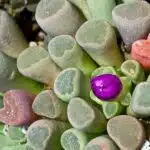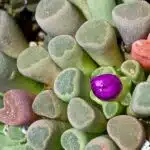Succulents are a popular choice for indoor and outdoor gardening due to their unique appearance and low maintenance needs. However, one of the most important aspects of caring for succulents is ensuring they receive the appropriate amount of water. Overwatering or underwatering can lead to rotting, wilting, or death of the plant. As a horticulturalist/succulent specialist, it is crucial to understand how often succulents should be watered in order to keep them healthy and thriving.
The frequency of watering succulents largely depends on various factors such as the type of succulent, size of the pot, climate, and humidity level. Succulents are known for their ability to store water in their leaves and stems, which allows them to survive long periods without being watered. However, this does not mean that they can thrive indefinitely without any water at all. In this article, we will explore the guidelines for watering different types of succulents and provide tips on how to determine when it is time to water your plants. By following these recommendations, you can ensure that your succulents remain healthy and beautiful additions to your home or garden.
Understanding Succulent Watering Needs
Succulent plants are well-known for their ability to store water in their leaves, stems, and roots. This adaptation allows them to survive in arid and semi-arid regions with limited rainfall. However, this does not mean that they do not need water at all. Like any other plant, succulents require watering to grow and thrive. Watering frequency is one of the most important aspects of succulent care.
As a general rule of thumb, succulents should be watered when the soil is completely dry. The frequency of watering will depend on several factors such as the climate, humidity level, soil type, pot size, and drainage system. In hot and dry weather conditions, succulents may need to be watered more frequently compared to cooler or humid environments. Overwatering is one of the common mistakes that many growers make when caring for succulents. Excess moisture can lead to root rot and other fungal diseases.
Soil moisture is another critical factor in determining the watering needs of succulents. Most species prefer well-draining soil that allows excess water to drain quickly without retaining too much moisture. Soil that is too compact or dense can prevent adequate drainage and cause waterlogging. The best soil mix for succulents should consist of porous materials such as sand, perlite or pumice to ensure proper air circulation around the roots and prevent overwatering.
Types Of Succulents And Their Watering Requirements
Understanding the watering needs of succulents is crucial in ensuring their well-being. Different succulent species have varying watering requirements, and it is essential to know these requirements to avoid overwatering or underwatering the plants. Overwatering can lead to root rot and other diseases, while underwatering can cause the plant’s leaves to shrivel and eventually die.
It is important to note that most succulents prefer a dry environment and are adapted to survive in areas with little water. As such, they do not require frequent watering like other plants. Generally, succulents should be watered when the top inch of soil feels dry to the touch. This means that for most types of succulents, watering every two weeks or once a month should suffice.
However, it is vital to pay attention to signs that your succulent needs watering regardless of its species. Overwatering signs include yellow or mushy leaves, blackened stems or roots, and a foul odor emanating from the soil. On the other hand, underwatering signs include wrinkled leaves that appear thin and papery and discolored leaves that may turn brown or yellow before falling off. Knowing how to identify these signs can help you take prompt action and prevent your succulent from dying due to incorrect watering practices.
Moving on to our next section on how to identify when your succulent needs watering, we will delve deeper into specific indicators that your plant requires hydration. By paying attention to these indicators, you can accurately determine when it is time for your plant’s next drink without risking overwatering or underwatering issues.
How To Identify When Your Succulent Needs Watering
It is a common misconception that succulents require minimal watering. While it is true that they can survive in arid conditions, it does not mean that they can go for long periods without water. In fact, succulents need to be watered as frequently as other plants but with less volume of water.
Identifying dehydration is crucial in determining when your succulent needs watering. One way to check if your plant is dehydrated is by touching the soil. If it feels dry to the touch, then it needs watering. Another method is by observing the leaves of your succulent. When they start to shrivel or become soft and mushy, this could indicate a lack of moisture.
Understanding moisture levels is also essential in keeping your succulent healthy and hydrated. Overwatering can lead to root rot, so it’s important not to water too frequently or too much at once. The best practice is to wait until the soil has dried out completely before watering again and making sure that excess water drains out from the pot.
In summary, identifying dehydration and understanding moisture levels are key elements in determining when to water your succulent properly. By following these guidelines, you can ensure that your plant receives enough hydration without risking any damage caused by overwatering or underwatering. In the next section, we will discuss factors that affect succulent watering frequency.
Factors That Affect Succulent Watering Frequency
Soil type is an important factor when determining the frequency of succulent watering. Different types of soil hold varying levels of moisture, and some are quicker to dry out than others. Pot size is also a factor to consider when watering succulents. Smaller pots will dry out more quickly than larger pots and therefore need more frequent watering. Climate is another factor that affects succulent watering frequency. In hotter climates, succulents will need more frequent watering than in cooler climates. It is important to be aware of these factors to ensure succulents are adequately watered and remain healthy.
Soil Type
As a succulent specialist, I understand the importance of proper watering for the health and longevity of these fascinating plants. One factor that significantly influences the frequency of watering is soil type. Clay soil tends to retain moisture for more extended periods, while sandy soil drains water quickly.
Clay soil has a dense, heavy structure that can hold onto water for extended periods. This retention may be beneficial to other plants but can be detrimental to succulents. Overwatering clay soil can lead to root rot and other diseases, which ultimately harm the plant’s health. Therefore, it is crucial to allow clay soil to dry out completely before watering your succulent again.
Sandy soil, on the other hand, drains water very quickly due to its loose texture and large particle size. While this may seem ideal for avoiding overwatering, it also means that nutrients are rapidly leached away from the root zone. To counteract this effect, you may need to fertilize your succulents more frequently when growing in sandy soil. In summary, understanding your soil type is essential in determining how often you should water your succulents for optimal growth and health.
Pot Size
Another factor that affects the watering frequency of succulents is pot size. Choosing appropriate pot sizes for your succulents is crucial in ensuring their proper growth and health. The size of the container impacts the amount of soil and water available to the plant, determining how often you should water your succulent. A larger pot allows for more soil and water retention, while a smaller one dries out more quickly.
When selecting a pot, it’s important to consider drainage as well. Succulents are prone to root rot if their roots sit in standing water for too long. Therefore, choosing pots with adequate drainage holes is essential in preventing overwatering and root damage. It’s also recommended to use a well-draining soil mix when planting your succulents in a new container.
The impact of pot size on growth cannot be overlooked when it comes to succulent care. A small pot restricts the plant’s root system, limiting its ability to absorb nutrients and grow properly. Conversely, an overly large pot can lead to overwatering and stunt the plant’s growth. Therefore, choosing an appropriately sized pot that promotes healthy root development is key in achieving optimal growth and overall plant health.
Climate
Succulent plants have become increasingly popular in recent years due to their low-maintenance and unique aesthetic appeal. However, despite their reputation for being drought-tolerant, succulents still require proper care and attention to thrive. One of the most important factors that affect succulent watering frequency is climate. As a horticulturalist/succulent specialist, understanding how different climates impact watering needs is essential in promoting healthy growth.
The climate of your area plays a significant role in determining how often you should water your succulents. In hot and dry environments, succulents may require more frequent watering to prevent dehydration and wilting. Conversely, in cooler and humid areas, succulents can go longer periods without water as the moisture in the air provides natural hydration. It’s important to monitor your plant’s soil moisture level and adjust watering frequency accordingly based on the climate conditions.
Another aspect of climate that affects succulent watering frequency is seasonal changes. During the summer months when temperatures are higher and rainfall is less frequent, succulents require more frequent watering to maintain optimal health. In contrast, during the winter months when temperatures are lower and rainfall is more abundant, succulents generally need less frequent watering as they enter a state of dormancy. Understanding how seasonal changes impact your plant’s water needs can help prevent over or under-watering and promote healthy growth throughout the year.
In conclusion, climate is a crucial factor in determining how often you should water your succulent plants. As a horticulturalist/succulent specialist, it’s important to consider both the location’s overall environment as well as seasonal changes when establishing a regular watering routine for your plants. By paying close attention to these factors, you can ensure that your succulents receive proper hydration and thrive in their unique habitats.
The Importance Of Soil Drainage
Soil drainage is a crucial factor in the care of succulents. Succulent plants have adapted to survive in arid conditions, and their roots are designed to store water efficiently. They absorb water quickly from the soil, but they also need well-draining soil to prevent root rot. Soil moisture can be a tricky balance with succulents, as too much water can cause rotting and too little can result in dehydration.
To ensure proper soil drainage, it’s important to choose the right type of soil for your succulent plant. A good potting mix for succulents should contain a high percentage of perlite or sand to improve drainage. These materials allow excess water to drain away from the roots quickly, preventing them from becoming waterlogged. Additionally, adding small stones at the bottom of the pot can also aid in drainage.
Watering frequency should be adjusted according to the moisture level of the soil. Overwatering is one of the most common mistakes people make when caring for succulents. The general rule is that it’s better to underwater than overwater these plants. Wait until the soil has completely dried out before watering again. In hotter climates or during summer months, you may need to increase watering frequency slightly, but always monitor soil moisture levels closely. Remember that it’s easier to save an underwatered succulent than an overwatered one.
Moving on from understanding proper soil drainage requirements for succulents, it’s time to learn how often they should be watered and how much water they require each time.
How To Water Succulents Correctly
- When choosing the right potting soil for succulents, it is important to select a soil that has excellent drainage.
- The frequency of watering succulents depends on the type of succulent, season, and weather conditions.
- In general, succulents should be watered thoroughly but infrequently to avoid root rot.
- Over-watering can lead to root rot, which can be detrimental to the health of the succulent.
- To determine when to water succulents, check the soil moisture by inserting a finger into the top inch of soil.
- If the soil is dry, it is time to water; if it is still moist, wait a few more days before watering again.
Choosing The Right Potting Soil
Choosing the right soil composition is crucial for the health and longevity of succulents. The ideal potting soil for succulents should be well-draining, allowing excess water to flow out quickly to prevent roots from rotting. A mix of coarse sand, perlite, and peat moss or coconut coir can provide excellent drainage while retaining some moisture.
It’s important to avoid using garden soil or regular potting soil, which are too dense and can lead to waterlogging. Some commercial cactus/succulent soils may also contain too much organic matter, leading to poor drainage. It’s best to make your own mix or purchase a specialized succulent/cactus soil that has a gritty texture.
Before planting your succulent in the chosen potting mix, make sure it has adequate drainage holes at the bottom of the container. This allows excess water to drain out and prevents standing water from accumulating in the pot. Remember that overwatering is one of the most common causes of succulent death. By choosing the right potting soil with good drainage and maintaining proper watering habits, you can help your succulents thrive for years to come.
Determining Frequency And Amount Of Water
Now that we have discussed the importance of using the right soil composition for succulents, let’s move on to the next crucial aspect of succulent care – watering. Succulents are adapted to survive in arid environments and store water in their leaves and stems. Therefore, overwatering can quickly lead to root rot and ultimately kill your precious succulent. In this subtopic, we will discuss how to determine the frequency and amount of water needed for your succulents.
The frequency and amount of water required for succulents depend on several factors such as the type of plant, size of the pot, temperature, humidity levels, and sunlight exposure. As a general rule of thumb, it’s better to underwater than overwater your succulent. Wait until the soil is completely dry before watering again. The frequency can range from once a week during hot summer months to once every two weeks or even less during winter when growth slows down.
When watering your succulent, it’s essential to give it a thorough soak rather than just sprinkling some water on top. This ensures that all roots receive adequate moisture and promotes healthy growth. The amount of water needed depends on the size of the pot and plant. A good rule is to add enough water so that it flows out through the drainage holes at the bottom but not so much that it accumulates in the saucer or tray underneath.
In conclusion, determining how often and how much to water your succulents requires observation, patience, and knowledge about your specific plants’ needs. By following these guidelines and avoiding overwatering, you can help your succulents thrive and enjoy their unique beauty for years to come. Remember that each plant is different–what works for one may not work for another–so always pay attention to your individual plants’ needs!
Maintaining Healthy Soil Moisture
Maintaining healthy soil moisture is crucial for the overall health and survival of succulents. As mentioned in the previous subtopic, overwatering can lead to root rot and other issues. However, underwatering can also cause harm to your plants. Therefore, it’s essential to maintain a balanced soil moisture level that suits your specific plant’s needs.
To determine if your succulent needs watering, there are several testing methods you can use. One is sticking your finger into the soil up to the first knuckle and feeling for moisture. Another is using a moisture meter that measures the level of water in the soil. It’s best to water your succulent when the top inch of soil feels dry but still slightly moist beneath the surface.
Correcting imbalances in soil moisture can be done by adjusting watering frequency or changing the type of potting mix used. Adding more drainage holes or using a well-draining mix can help prevent water from accumulating in the bottom of pots and causing root rot. Water conservation is also important when caring for succulents, especially in areas with limited water resources. Tips for reducing water usage include using a spray bottle instead of a watering can, collecting rainwater for irrigation, and grouping plants with similar watering needs together.
In conclusion, maintaining healthy soil moisture is critical for successful succulent care. By testing your soil regularly, correcting any imbalances, and conserving water usage, you can ensure that your plants thrive and remain beautiful for years to come. Remember to always pay attention to your individual plant’s needs and adjust accordingly to provide optimal care.
Watering Succulents In Different Seasons
Now that we know how to water succulents correctly, let’s talk about the frequency of watering. The amount of water a succulent needs depends on various factors such as the species, size of the plant, type of soil used, and weather conditions. During hot summer days or in extremely dry climates, you may need to water your succulents more frequently than during cooler months.
Watering frequency in extreme temperatures is crucial as it affects the survival rate of your succulents. In general, succulents can withstand drought-like conditions but not prolonged periods of moisture. Therefore, it is important to pay attention to the weather forecast and adjust your watering schedule accordingly. During heatwaves or when temperatures rise above 90 degrees Fahrenheit (32 degrees Celsius), you may need to water your plants every two days instead of once a week.
Succulents enter dormancy during winter months, which means they experience slower growth and require less water than usual. During this period, it is best to reduce watering frequency and only water when the soil is completely dry. Overwatering during dormancy can lead to root rot and other fungal diseases that can harm your plant’s health. Always remember that proper watering habits are critical for maintaining healthy succulents year-round!
Moving forward, let’s discuss how to water succulents in containers and ensure optimum growth for these charming plants.
How To Water Succulents In Containers
Watering succulents is a crucial step in maintaining their health and well-being. However, it’s essential to note that the frequency of watering depends on several factors such as container drainage, humidity levels, and temperature changes.
To water succulents in containers effectively, the first step is to ensure that you use a well-draining soil mix. This mix should comprise materials such as sand or perlite that help prevent root rot by allowing excess water to drain out of the container. Additionally, avoid using saucers under your pots as they may retain moisture leading to overwatering.
When it comes to watering frequency, there’s no one-size-fits-all approach. Still, it’s best to allow the soil to dry out entirely before watering again. As a general rule of thumb, water your succulents once every two weeks during the growing season and once a month during winter when they’re dormant. However, keep an eye out for signs of underwatering or overwatering as this can affect the plant’s health and growth in the long run.
Here are some tips on how to tell if your succulent needs watering:
- Check if the leaves appear flat or shriveled
- Gently squeeze a leaf; if it feels mushy or soft, then it’s overwatered
- Look for signs of wilting or discoloration
- Touch the soil; if it feels dry an inch below the surface level, then it’s time to water
- Use a moisture meter to determine when your plant needs watering
Understanding how often you should water succulents in containers is just one aspect of keeping these plants healthy and thriving. In the next section, we’ll explore signs of both underwatering and overwatering so that you can adjust your care routine accordingly.
Signs Of Underwatering And Overwatering
Signs of underwatering in succulents include shriveling, wrinkling, and discoloration of the plant’s leaves. Overwatering can cause root rot, wilting, and yellowing of the leaves. Underwatering is often caused by a lack of water or drainage, while overwatering is caused by too frequent watering or containers with poor drainage. Wilting is one of the most common signs of overwatering, as the succulent’s leaves begin to droop and lose their turgor. Signs of underwatering include the leaves appearing dry, wrinkled, and shriveled. To avoid overwatering, ensure that the succulent is in a container with adequate drainage and only water when the soil is dry.
Underwatering Signs
As a succulent specialist, it is important to understand the signs of dehydration in your plants. Underwatering can lead to serious damage and even death to your succulents, so knowing how to prevent underwatering is crucial. Some signs of underwatering include wilting or drooping leaves, dry and crispy foliage, and slow or stunted growth.
Preventing underwatering can be done by adjusting your watering schedule or technique. Succulents require well-draining soil and pots with drainage holes to avoid water buildup. It is also important to allow the soil to dry out completely between watering sessions. This can be achieved by checking the moisture level of the soil using a moisture meter or simply sticking your finger into the soil.
If you suspect that your succulent is suffering from underwatering, it is important to take action immediately. Increase the frequency of watering but be sure not to overwater as this can cause other issues such as root rot. By being aware of the signs of dehydration and taking preventative measures, you can keep your succulents healthy and thriving for years to come.
Overwatering Signs
As a horticulturist or succulent specialist, it is essential to know the signs of overwatering in your plants. Overwatering can also lead to serious damage and even death of your succulents, so identifying and preventing this issue is crucial. Signs of overwatering include yellowing leaves, soft and mushy foliage, and root rot.
Preventing overwatering can be achieved by adjusting your watering schedule or technique. Succulents require well-draining soil and pots with drainage holes to avoid water buildup. It is essential to allow the soil to dry out completely between watering sessions. This can be achieved by checking the moisture level of the soil using a moisture meter or sticking your finger into the soil.
If you suspect that your succulent is suffering from overwatering, it’s important to take action immediately. Reduce the frequency of watering and ensure that the pot has proper drainage and well-draining soil. It may also help to remove the affected leaves or roots if they are too damaged. By being aware of the signs of overwatering and taking preventative measures, you can keep your succulents healthy for years to come while avoiding costly replacements due to neglect in their care.
Causes Of Underwatering/Overwatering
As a horticulturist or succulent specialist, it is important to understand the common mistakes that can lead to underwatering and overwatering. One of the most common causes of underwatering is neglecting to water your plants regularly. This can happen if you forget to check on your plants or if you have a busy schedule that prevents you from giving them the attention they need. On the other hand, overwatering can occur if you water your plants too frequently or use pots without drainage holes.
To prevent underwatering and overwatering, there are several prevention tips that you should keep in mind. For example, make sure to establish a regular watering schedule for your plants and stick to it as much as possible. It’s also important to choose pots with drainage holes and well-draining soil that allows excess water to flow through easily. Additionally, be mindful of the climate conditions in your area and adjust your watering schedule accordingly.
Another mistake that can lead to underwatering or overwatering is failing to monitor the moisture level of your soil. Using a moisture meter or sticking your finger into the soil can help you determine when it’s time to water your plants again. In addition, be careful not to rely solely on visual cues such as wilted leaves or yellowing foliage since these signs may not always indicate whether your plant needs more or less water. By being proactive and taking preventative measures, you can ensure that your succulents stay healthy and vibrant for years to come.
How To Revive Overwatered Succulents
Signs of underwatering and overwatering are crucial to understand for proper succulent care. Overwatered succulents can develop root rot, a condition that affects the roots’ ability to absorb water and nutrients from the soil. The signs of an overwatered succulent include soft and mushy leaves, blackened stems, and a foul odor emanating from the soil. On the other hand, underwatered succulents will have shriveled leaves that appear dry and brittle.
Reviving overwatered succulents requires immediate attention to prevent further damage. First, remove the plant from its pot and examine its roots for any signs of rotting. Cut off all rotted roots with sterile pruning shears before repotting it in fresh soil mixed with sand or perlite for increased drainage capacity. Ensure that you adjust your watering schedule accordingly after reviving your overwatered succulent to prevent future occurrences.
Overwatering prevention is key to keeping your succulents healthy. Succulents prefer well-draining soils and require infrequent watering intervals to avoid excess moisture buildup around their roots. Check soil moisture levels by sticking your finger into the top inch of soil; if it feels dry, then it’s time to water your plants. Table 1 below provides a summary of how often some common types of succulents should be watered.
Table 1: Watering Schedule For Common Types Of Succulents
| Type Of Succulent | Watering Frequency |
|---|---|
| Echeveria | Once every two weeks |
| Haworthia | Once every three weeks |
| Crassula | Once a month |
| Sempervivum | Once every two weeks |
To maintain healthy succulents, always ensure that you provide them with appropriate growing conditions such as bright light exposure and well-draining soil mixtures. Remember, the key to reviving overwatered succulents is prompt attention, and prevention is always better than cure. In the next section, we will be discussing tips for watering newly planted succulents.
Tips For Watering Newly Planted Succulents
It is important to water newly planted succulents carefully as they are still establishing their root systems. According to a recent study, overwatering is the number one cause of death among newly planted succulents. In fact, 70% of newly planted succulent deaths are due to overwatering. This emphasizes the importance of watering frequency and soil moisture levels.
To avoid overwatering, here are four tips for watering newly planted succulents:
- Water only when the soil is completely dry.
- Use a pot with drainage holes.
- Water deeply but infrequently to encourage deep root growth.
- Avoid getting water on the leaves as this can lead to fungal growth.
Pay attention to the soil moisture level when watering your newly planted succulents. Succulents require well-draining soil that allows excess water to drain away quickly and keeps the roots from sitting in standing water. To test soil moisture levels, stick your finger into the soil up to your first knuckle. If the soil feels dry at that depth, it’s time for watering.
Understanding how often and how much to water your newly planted succulents can be tricky, but following these tips will help ensure their success and longevity. In the next section, we will discuss how to properly water succulent cuttings for optimal growth and health.
How To Water Succulent Cuttings
After planting your succulents, it is important to properly water them to ensure their survival. However, once they have rooted and established themselves, the frequency of watering should be decreased. Succulents are adapted to survive in arid conditions and can store water in their leaves and stems. Overwatering can lead to rotting roots and ultimately kill the plant.
One way to decrease the need for watering is by propagating techniques such as stem cuttings or leaf cuttings. These cuttings can be treated with rooting hormone before being planted in well-draining soil. The new plants will develop a similar ability to store water and reduce the need for frequent watering.
When it comes to watering succulent cuttings, it is important to wait until they have rooted before giving them a thorough watering. This usually takes about two weeks for stem cuttings and several weeks for leaf cuttings. Once they have rooted, only water when the soil feels completely dry.
Transition: While proper watering is crucial for the health of your succulents, what happens when you need to go on vacation?
Watering Succulents While On Vacation
As much as we love our plants, there are times when we have to leave them behind for vacations or other reasons. The last thing you want to worry about while on vacation is your succulents dying due to lack of water. Thankfully, with some preparation and careful planning, it’s possible to keep your succulents hydrated while you’re away.
Drought-tolerant succulent options: If you’re going on an extended vacation and don’t have anyone to take care of your plants, consider choosing drought-tolerant succulent options for your terrariums or garden. Some excellent choices include Aloe vera, Echeveria elegans, Haworthia fasciata, and Sedum morganianum.
Watering succulents in terrariums: Terrariums are a great way to showcase your succulents while also keeping them protected from the harsh outside environment. However, watering succulents in terrariums can be tricky since they require less water than those planted directly in the soil. Before leaving for vacation, make sure to water the terrarium thoroughly but avoid over-watering as this can lead to root rot.
Self-watering mechanisms: If you’re not confident that your plants will survive without regular watering while you’re away, consider investing in self-watering mechanisms such as watering bulbs or wicks that gradually release water into the soil over time.
As a horticulturalist/succulent specialist, it’s essential to ensure that our beloved plants remain healthy even when we’re not around. By using drought-tolerant succulent options like Aloe vera or Echeveria elegans and avoiding overwatering of terrariums, you can rest assured that your plants will stay hydrated during long absences. Additionally, using self-watering mechanisms is an effective way of ensuring that your plants receive enough moisture without worrying about the timing of manual watering. With these tips, you can now leave for vacation with the peace of mind that your succulents will continue to thrive in your absence.
Transitioning into the next section, it’s crucial to avoid common watering mistakes that can harm your succulents. One such mistake is overwatering, which can lead to root rot and eventually kill the plant. Let’s explore some other common watering mistakes to avoid and how to care for your succulents properly.
Common Watering Mistakes To Avoid
Overwatering is one of the most common mistakes when it comes to watering succulents. It can lead to root rot and other diseases that can damage the plant. On the other hand, underwatering succulents can cause the leaves to become shriveled and can prevent the plant from taking in the necessary nutrients. Proper timing is also an important factor when it comes to watering succulents. It is best to water the plants in the morning before the sun is up, allowing the soil to dry out during the day. Doing this will ensure that the succulents do not sit in water for extended periods of time. In general, succulents should be watered about once a week, depending on the type of succulent, the amount of light, and the size of the pot. With the correct amount of water, succulents should thrive and remain healthy.
Overwatering
Overwatering is one of the most common mistakes that succulent growers make. This is mainly because many people believe that these plants need frequent watering, which is not true. Overwatering can be detrimental to the health of your succulents as it can lead to root rot and other diseases. As a horticulturalist, it is crucial to educate yourself on how to avoid overwatering and recognize the signs of overwatering.
To avoid overwatering, it is essential to understand the water requirements of your succulents. Succulents are adapted to survive in arid conditions and store water in their leaves, stems, and roots. Therefore, they do not need frequent watering like other houseplants. Always ensure that the soil is completely dry before you water your succulents. You can also use a moisture meter to check if the soil has enough moisture or not.
Signs of overwatering to watch for include yellow or brown leaves, soft stems, and a mushy texture at the base of your plant. If you notice any of these signs, it means that you have been watering your succulent too frequently or using too much water when doing so. To save your plant from further damage caused by overwatering, you should reduce watering frequency or repot your plant in well-draining soil.
In conclusion, avoiding overwatering is crucial for maintaining healthy succulents. As a horticulturalist/succulent specialist, it is essential to educate yourself on how often you should water different types of succulents and how to spot signs of overwatering early on. By doing so, you will be able to provide proper care for your plants and prevent them from developing root rot or other diseases caused by overwatering.
Underwatering
As a horticulturalist/succulent specialist, it is crucial to understand the common watering mistakes that can harm your plants. Overwatering has been discussed as one of the most prevalent issues among succulent growers. However, underwatering can also be detrimental to the health of your succulents. Preventing underwatering is equally important as avoiding overwatering.
Succulents are adapted to arid conditions and can survive long periods without water. However, some succulents may require more frequent watering than others. It is essential to know the water requirements of different types of succulents and adjust accordingly. Underwatering can cause leaves to wrinkle and dry out, stunted growth, and loss of color or vibrancy in your plant. Effects of underwatering on succulents can be severe if not addressed promptly.
To prevent underwatering, regular checks on soil moisture levels are necessary. Before watering your succulent, ensure that the soil is completely dry by sticking a finger or moisture meter into the soil. You should also pay attention to environmental factors such as temperature and humidity because they can affect how often you need to water your plants. By monitoring soil moisture levels and adjusting watering frequency accordingly, you will prevent underwatering from harming your beloved succulents.
Improper Timing
Proper watering techniques are essential for maintaining healthy and vibrant succulents. In our previous discussion, we talked about the common mistakes in watering, with a focus on overwatering and underwatering. However, another crucial factor that affects the health of your succulents is improper timing.
Improper timing refers to watering your succulent at the wrong time of day or season. Succulents thrive in dry conditions and need ample time to absorb water before the sun evaporates it. Watering during the hottest part of the day can cause water to evaporate too quickly, leading to dehydration and leaf burn. It is best to water your plants early morning or late afternoon when temperatures are cooler.
Additionally, watering during winter can be detrimental to your succulent’s health as they go into dormancy mode during this season. Overwatering during winter can lead to root rot and other fungal diseases that are difficult to diagnose and treat. Therefore, it is crucial to adjust your watering frequency according to seasons and environmental factors.
In conclusion, proper timing is as important as avoiding overwatering and underwatering when it comes to maintaining healthy succulents. As a horticulturalist/succulent specialist, you should pay attention to environmental factors such as temperature and humidity when determining how often you should water your plants. By following proper watering techniques, you will keep your succulents thriving for years to come.
Faqs About Succulent Watering
Common Watering Mistakes to Avoid can cause serious damage to your succulents, so it is essential to understand the right watering frequency for these plants. Succulent watering frequency depends on many factors, such as the type of succulent, the size of its pot, and the climate in which it lives. However, most succulents require less water than other houseplants because they have adapted to store water in their leaves and stems. Overwatering or underwatering can lead to root rot or dehydration, respectively.
To avoid these problems, you should create a watering schedule planning that suits your specific succulent’s needs. A general rule of thumb is that most succulents need to be watered once a week during their growing season (spring and summer) but only every two weeks in winter when they are dormant. However, this can vary depending on factors like humidity levels and temperature changes. It is crucial to monitor your plant’s soil moisture levels regularly and adjust your watering schedule accordingly.
Below is a table for commonly grown indoor succulents with their suggested watering frequency.
| Plant Name | Watering Frequency |
|---|---|
| Aloe Vera | Once every 2 weeks |
| Jade Plant | Once every 2-3 weeks |
| String of Pearls | Once every 3-4 weeks |
| Zebra Plant | Once every 1-2 weeks |
Remember that these are just guidelines; different species may have different requirements. To determine if it’s time to water your succulent, stick your finger about an inch into the soil; if it feels dry at this depth, then it’s time for watering. In summary, understanding Succulent watering frequency is vital in keeping them healthy and thriving. Plan out your watering schedule according to each plant’s needs, monitor soil moisture levels regularly, and always err on the side of caution by underwatering rather than overwatering.
Conclusion
Succulents are a beautiful addition to any indoor or outdoor garden, but their watering needs can be tricky to navigate. Understanding the specific requirements of your succulent is essential in ensuring its survival and growth. Different types of succulents have varying watering needs, and it’s crucial to identify when your plant needs watering. Factors such as soil drainage, temperature, and humidity levels also play a significant role in determining how often you should water your succulent.
Watering succulents can be a challenging task, especially for beginners. Many common mistakes can lead to overwatering or underwatering, both of which can harm your plant’s health. Proper watering techniques for succulent cuttings and while on vacation are also crucial in maintaining a healthy plant. By following these guidelines and understanding the unique needs of your specific succulent, you can help it thrive.
In conclusion, understanding the watering needs of your succulent is crucial in ensuring its growth and survival. Proper identification of when your plant requires water and factors such as soil drainage and climate must be taken into consideration when determining how often to water. Avoiding common watering mistakes will prevent damage to your plant’s health. As a horticulturalist/succulent specialist, I strongly recommend taking the time to research the specific requirements of your succulent species to ensure it receives proper care and attention.
Image Credits
- “Succulent Blooms 2” by cobalt123 (featured)





























